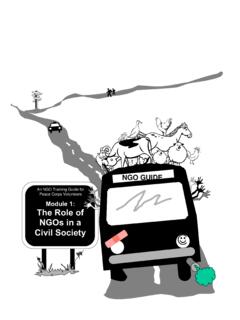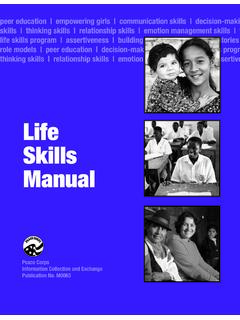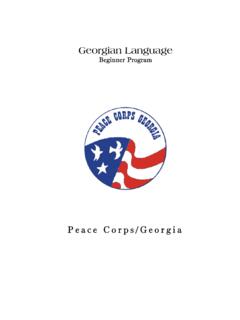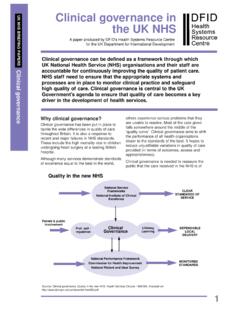Transcription of Effective NGO Governance - Peace Corps
1 NGO GUIDE An NGO Training Guide for Peace Corps Volunteers Module 5: Effective NGO Governance An NGO Training Guide for Peace Corps Volunteers Module 5: Effective NGO Governance page 145 MODULE 5 Effective NGO Governance good Governance is key to the growth and sustainability of nongovernmental organizations (NGOs). Module 5, Effective NGO Governance , presents methods and techniques for planning and implementing actions to improve an organization s Governance . By the time you have finished the reading and activities you should have acquired the knowledge, skills, and attitudes to: List the two major responsibilities of an NGO s governing body and provide at least three examples of how this group carries out each of these responsibilities. Differentiate between the following word pairs.
2 (Suggested responses are located at the end of the module.) Governance management monitoring evaluation NGO s purpose NGO s mission statement articles of incorporation bylaws standing committee ad hoc committee facilitator authoritative leader Summarize, in 35 words or fewer, how the new work of boards improves Governance . (A suggested response is found at the end of this module.) Demonstrate an understanding of the strategic planning process by correctly completing the following statements. (Suggested responses are located at the end of the module.) Strategic planning involves a time frame greater than _____. To ensure buy-in by the NGO s stakeholders the planning process should be_____. Before writing goals and objectives, planners need to survey the organization s _____ and _____ environment and clarify the organization s _____ and _____.
3 The NGO s _____ usually prepares the strategic plan; the plan must be approved by the NGO s _____ or _____. Describe two or more activities a Volunteer might institute with his or her Counterpart(s) or coworkers to improve the Governance of an NGO. An NGO Training Guide for Peace Corps Volunteers Module 5: Effective NGO Governance page 146 NGO Governance An NGO s sustainability its ability to serve its clients over the long term depends largely on the quality of the organization s Governance . In this module we explore who governs an NGO, how they govern, what factors contribute to Effective Governance , and the roles a Peace Corps Volunteer (PCV) might play in improving an NGO s Governance . Your ability to work successfully with NGO stakeholders to improve the organization s Governance depends on several personal competencies: Your people, language, and cross-cultural skills; Your energy, motivation, and attitude; and Your understanding of the basics of NGO Governance .
4 An NGO Training Guide for Peace Corps Volunteers Module 5: Effective NGO Governance page 147 ACTIVITY 5:1 NGO Governance QUIZ Test your knowledge of NGO Governance by taking the following quiz. Instructions: Match each phrase/word in the left column with a phrase/word in the right column. There may be more than one correct match for each item. _____ 1. Ad hoc committee a. Board of directors _____ 2. Advisory committee b. Chairperson/President _____ 3. Articles of Incorporation c. Clients _____ 4. Bylaws d. Composed of experts _____ 5. Leader of NGO s e. Description of an NGO s work governing body _____ 6. Mission statement f. Executive committee _____ 7. NGO s governing body g. Executive director _____ 8. NGO s chief operating h. Finance committee officer _____ 9. NGO stakeholders i. Legal document j.
5 Nominating committee k. Rules for conducting an NGO s affairs l. Group is terminated when its tasks are completed Check your answers with those suggested at the end of the module. An NGO Training Guide for Peace Corps Volunteers Module 5: Effective NGO Governance page 148 Information by itself is not knowledge; it requires the addition of experience and consideration. Philip Crosby NGOS WITH A HIGH LEVEL OF Governance CAPACITY To understand Effective NGO Governance , we look first at a typical Governance structure of an NGO with a high level of capacity. A clear picture of Effective Governance makes it easier to plan actions that move an NGO in the direction of better Governance . As you read through the next few pages, your reaction will probably be, But the NGOs where I am do not function like this!
6 You are probably right. Most NGOs lack Effective Governance . Later, we will discuss the NGO realities that Volunteers frequently encounter. NGOs are directed and controlled by a governing body, or a board of directors. You may also encounter names such as board of governors or board of trustees. In most countries, the board has a legal, moral, and fiduciary responsibility for the organization. Board s Major Responsibilities Acquire and protect the organization s assets Make certain the organization is working to fulfill its mission At their best, boards reflect the collective efforts of accomplished individuals who advance the institution s mission and long-term welfare. The board s contribution is meant to be strategic and the joint product of talented people. People on a board are brought together to apply their knowledge, experience, and expertise to the major challenges facing the institution.
7 Strategic thinking and oversight characterize the board s leadership role. An Effective board organizes itself to carry out its duties and responsibilities. To manage the day-to-day operations of the NGO, the board of directors appoints an executive director, sometimes called the chief of operations (CEO). Tensions and inefficiencies result if responsibilities, authority, and working relationships of board and staff are not clearly defined. An NGO Training Guide for Peace Corps Volunteers Module 5: Effective NGO Governance page 149 * * * * * * * * * A LEARNING MOMENT The executive director, as you can imagine, has many duties. He/she administers and manages all day-to-day operations of the organization, including: hiring and supervising staff, monitoring programs and finances, providing ongoing leadership, advising and reporting to the board on the NGO s operations, and speaking on behalf of the organization as delegated by the chairperson/president of the board.
8 * * * * * * * * * In our discussion of Effective Governance , the information is broken into three topics: board structure, governing documents, and board functions. BOARD STRUCTURE Boards tend to work effectively when they are structured to carry out each unique mission of the NGO and maximize the individual talents of board members. Dividing the board into committees is a common mechanism for: Organizing the board s work to accomplish the NGO s mission. Preparing board members for making informed decisions. Using board members skills and expertise ( , a board member with financial experience serves on the finance committee and one with a deep understanding of the clients needs serves on the program committee). Providing opportunities to become involved and serve the organization.
9 Below is an example of one board structure for a high-capacity NGO. Keep in mind that no one board structure is a good fit for all NGOs. Chairperson of the Board Usually is elected by the board for a set term. Presides over general board meetings. Speaks on behalf of the organization to the public and media. Chairs the executive committee. An NGO Training Guide for Peace Corps Volunteers Module 5: Effective NGO Governance page 150 Vice Chairperson Usually succeeds the chairperson at the end of his or her term in office. Assists the chairperson and serves in his or her absence. Often chairs the nominating committee. Standing Committees Normally are described in the bylaws. Usually include the: Executive Committee: Board chairperson/president, vice chairperson, secretary, and treasurer.
10 Executive committee has authority to make certain decisions between meetings. Finance Committee: The treasurer usually chairs this committee. It provides financial oversight for the organization, advises the board on the budget and financial affairs. Nominating Committee: Often chaired by the NGO s vice chairperson. Identifies new board members and nominates individuals to serve as NGO officers. Ongoing Committees Normally not prescribed in the bylaws, but necessary to achieve the organization s mission. Might include a program committee, marketing committee, research committee, education committee, etc. Allow the board more flexibility to conduct its business and tailor committees to fit the mission of the organization. Ad Hoc Committees or Task Forces Given assignments to be completed in a specified time (fundraising or a special event).













